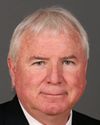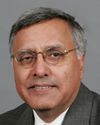Honourable members of Parliament, good afternoon.
It's my privilege this afternoon to provide you with an update of Canadian Forces operations in Afghanistan. I've structured my update to include a brief overview of ISAF and Regional Command South, an overview of the CF elements deployed both in Kandahar and Kabul, and finally a snapshot of some of the CF activities and accomplishments over the last few weeks and months.
Mr. Chairman, let me state up front that I've developed this brief to the best of my ability, but I can, for future briefings, adjust my format to suit your needs and obviously the discussion that has ensued from this.
Finally, while the CF works with many other government departments to make a valued Canadian contribution, my presentation will focus on military efforts. I'm certainly prepared to provide clarification on my presentation if I can, but questions on activities of other departments are probably best addressed by them.
I hope you'll find the slides useful, so that I don't just speak on text.
I think it's always worth reflecting on what our aims are in Afghanistan. The soldiers understand these, but they have a unique way of their own of boiling down and getting to the essence in simple words of why they think they're serving there. Having interacted with a number of soldiers, especially in the preparation of those soldiers who serve in Afghanistan now who were from Petawawa in my previous employment as the brigade commander, what resonates through—and we've heard the soldiers speak—is that their reason for being in Afghanistan is simple: “I want to make a difference in Afghanistan and to help Afghans.” That's how they boil down some of these aims that appear on the slide.
We are in Afghanistan to defend Canadian interests, hand in hand with our allies and the Afghan people. Our goal is to expand stability, security and the democratic independence that forever rejects terrorism, its methods and its support.
The purpose of the mission is to protect Canadians against terrorist threats before they reach our shores, but it's also about helping the Afghan people rebuild their lives and their country. The multidimensional involvement of the Canadian Forces in Afghanistan requires action on three levels of governance: supporting and advising the Afghan government and national security forces at the national level; leading the multinational brigade at the regional level; and providing a strong battle group and provincial reconstruction team at the provincial level in Kandahar.
Turning to the next slide, the NATO-led mission in Afghanistan is a multinational endeavour. Over thirty nations are actively engaged in providing assistance to the Afghan government. Progress is being achieved throughout the country, and despite the challenges we face in the southern region, most of the rest of the country has advanced, albeit slowly. I think it's always important to put up a map to show the entire country, because there are some great things going on. Canadians can be proud of what we've accomplished in Kabul and what the international community accomplishes in at least 75% of the country. There's no doubt about it: we have some challenges in the south.
The expansion and transfer of the NATO ISAF mission from the U.S.-led Operation Enduring Freedom is now complete. General Richards from the United Kingdom is the ISAF commander based in Kabul who is directing all ISAF activities. Operation Enduring Freedom continues; however, its focus is on counter-terrorism.
In Regional Command South, the next slide shows that the relatively recent introduction of NATO nations, which really began earlier this year, has been challenging, to say the least. This map shows you that our partners in the southern region include the British, along with some Estonian troops in Helmand province, and they number some 3,800. I'm sorry the slide is hard to see.
The Dutch are coupled with the Australians in Oruzgan province. There are 1,200 Dutch, 360 Australians, and a Romanian contingent with some U.S. support—800 Romanians and about 400 Americans.
All four groups in these four provinces have roughly the same type of contribution, namely a battle group to provide security and a provincial reconstruction team to help advance development efforts and governance efforts. All four are confronted by the same challenge, namely the Taliban, which seeks to undermine the Afghan government and would really prefer NATO to leave before the Afghans can establish credible plans for a local security apparatus, which is vital to any nation state.
The focus of all NATO battle groups and their PRTs, led by Regional Command South, are essentially the same, namely to make best efforts to establish a secure environment, help grow Afghan governance capability—in other words, help the governor build his bureaucracy—and assist a variety of international organizations and non-governmental organizations in their efforts.
The U.K. force has newly rotated into theatre, so their focus over the last two weeks has been to adjust to Helmand province. The Dutch flowed into Oruzgan province in the late summer and are also acquainting themselves with their area of operations.
As you are all aware, the focus of the Canadian battle group has been just to the west of Kandahar city in the Panjwai and Pashmul regions. Taliban efforts and actions to terrorize the local population in this area, to establish a permanent presence, and to attack Canadians and local Afghans with IEDs and suicide bombers seriously disrupted the governor of Kandahar's ability, aided by the PRT and many others, to pursue much development. Operation Medusa, which has recently been completed, was successful in getting large concentrations of Taliban to leave their fixed defensive positions just to the west of Kandahar city; however, the Taliban still remain a threat.
While the Canadian effort remains focused on this area, we are working hard to expand our influence within the entire province. Efforts—and these are efforts that are similar to those in every province in Afghanistan—look to grow the Afghan National Army and the Afghan National Police capacity so that they can serve in the areas we operate in and allow us to expand our efforts.
This is a tremendously important subject, building the capacity of the local Afghan army and police themselves to provide security within their own country, and it is a solid foundation of our efforts in Afghanistan.
Over the last two weeks, Lieutenant-Colonel Omer Lavoie and his battle group have been working to improve the professionalism of the Afghan National Army soldiers partnered with them. While we only have a few hundred presently, this represents an important milestone.
We need to further grow the Afghan army capacity to provide security. We have created an observer and mentor liaison team of approximately fifty soldiers to work with the Afghan army assigned to Kandahar province. Hopefully, over the next couple of years we can significantly grow this capacity.
Over the last few weeks the provincial reconstruction team has continued its work with local Afghans, and I will cover some of the accomplishments they have achieved in a little more detail.
I have three slides that talk about the Canadian Forces in Kandahar and Kabul, but in the interest of time, I will skip over them. I think you're all aware of the Canadian contribution there. I suggest we roll over the slides on our forces in Kandahar and Kabul, and if you wish me to come back to them, I will be happy to do that.
Next I'd like to discuss some of the accomplishments the Canadian Forces and Canada have achieved over the last several months.
Brigadier-General David Fraser officially led the multinational Regional Command South within the international forces for nine months, starting February 28, 2006. The goal was to ensure regional development and stabilization. Under his command of the South Region, the Brigadier-General and his troops achieved several major accomplishments. Some of these include: facilitating the establishment of operational forces in the Helmand and Uruzgan region; enabling the transfer of the operation under NATO control; reinforcing governance within the province of Kandahar; developing Afghan development areas in the South Region; enabling joint operations between our forces, coalition forces and Afghan security forces. Large numbers of insurgents were driven out of the Panjwai region during Operation Medusa.
These are tremendous accomplishments under very challenging conditions. Are things perfect in the south? Far from it. But progress, albeit slow, has been made. Brigadier-General Fraser will pass command to a Dutch general this week, and he and his team of 200 Canadians and the other nations that were represented in the headquarters will head home after nine months of hard work for a well-deserved break. All Canadians can be proud of what's been accomplished by Dave Fraser and his team.
Security is essential to promote stability. There cannot be long-term development if security is not achieved. Therefore, as part of our security mandate, our battle group is deployed in Kandahar province, the former Taliban heartland. In order to remove terrorist safe havens and create, bit by bit, security in development zones, the Canadian battle group, with the Afghan National Army, the Afghan National Police, and the Afghan national auxiliary police, are currently securing the ground in the Pashmul, Panjwai area, as I described earlier, in order to enable development.
Apart from the usual patrol framework, vehicle checkpoints and forward operating bases have been created to permanently secure the land and ensure that the Government of Afghanistan can stand on its own two feet.
Many challenges are still in front of us. However, as the Afghan national security forces' capacity grows and develops into a professional organization, it's our belief that the advantages and local benefits of a strong central government will be felt by the Afghans, and they will accept that there can only be one future. It's a future that leaves the Taliban behind.
The Kandahar Provincial Reconstruction Team, headed up by a Canadian using multinational players, conducts coordinated interdepartmental operations to promote good governance and to assist the Government of Afghanistan. Through ongoing contact with government officials, including the governor of Kandahar province and the elected provincial council, as well as with local tribal, religious, and opinion leaders, the PRT contributes to the efforts to improve security and enable stability.
The PRT is a key member of the Kandahar disaster management committee, which coordinates relief efforts with NGOs and the United Nations. The PRT has assisted in the distribution of food, water, blankets, and tents throughout the Panjwai region. DND funding, in the form of a commander's contingency fund, was established at $2.4 million Canadian and is to be used, at the discretion of the commander, to assist with development and security efforts in the area of operations. Sixteen of 27 projects have been completed in the timeframe of our being in Kandahar province. That equates to more than $700,000 having been spent, from a DND perspective, on this endeavour.
Let me list a few of the other accomplishments to give you a sense of what the PRT is doing. The PRT has purchased medical supplies for the Afghan National Police hospital and has established a form of an Afghan National Police dispatch system, which is similar to a 911 system that we would recognize back here in Canada.
The PRT also provides mentoring by the RCMP to the local Afghan National Police. The provincial reconstruction team has provided more than 1,000 police uniforms, which were obtained from the local economy. We have also provided essential basic policing equipment, such as winter coats, boots, flashlights, belts, and gloves to the registered police.
A third accomplishment, of many, is that the PRT has improved the plumbing system of the city of Kandahar women's prison. A total of nine village medical outreach activities were conducted, four of which have been conducted in the last six weeks. More than 2,000 Afghans have received basic medical care and material assistance in remote areas, from Panjwai to Nazyan, in Kandahar province.
Finally, as an example, a generator was provided for the Cloak of the Prophet shrine in Kandahar city. This is representative of the wide range of assistance coordinated by the PRT in trying to help local Afghans.
I won't spend any time on the strategic advisory team. You've met with my colleague, Mike Capstick, who has given you a good briefing on the strategic advisory team, a part that's not well known to Canadians but certainly is trying to make a difference in the governance from the Kabul end, and, again, I think it is an outstanding endeavour.
Let me conclude by stating that we face many challenges in Kandahar province. There can be no doubt about that. The soldiers and officers I talk to, who I know well and who are on that deployment, feel that Canada is making a big difference. But they are very realistic about the amount of time this will take to achieve, so that Afghanistan can go it alone.
At this point, Mr. Chair, I'd be happy to address some questions.





